A SHORT RECAP OF THE ORIGINAL 1933 MOTION PICTURE
On March 7, 1933 New Yorkers saw their city in panic from a giant gorilla named Kong. Depending upon the sequence of the picture his size varied. He was either 18, 24, 35, 50, or 70 feet tall. In short one hell of an ape. The above date was the premier of the motion picture "King Kong" co-produced and co-directed by the team of Merian C. Cooper and Ernest B. Schoedsack. The original story was by Cooper and mystery writer Edgar Wallace.

In the practice still shown next of the mechanical hand used for King Kong. Fay Wray is seen being held in it's palm. Wray was 5 feet 3 inches in height. So consider how large King Kong must be in relation to her. For this scene to work the 1933 Kong has to be at least 70 feet tall. Most people consider him to be only 25 feet in height. Slightly taller than the average two story house. .
In these exciting scenes from the 1933 film. King Kong fights a Tyrannosaurus. The height of a Tyrannosaurus was 40 feet and the scenes seems to make Kong appear about 30 to 35 feet.
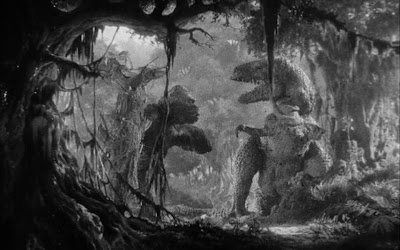
The original Kong was designed and stop motion animated by Willis O'Brien. O'Brien designed King Kong to be 18 feet tall and the actual model built by Marcel Delgado was to that dimension. Merian C. Cooper envisioned a Kong of approximately 50 feet in height and this was the way the novel released prior to the motion picture depicted him. The RKO Press Book for the motion picture also listed King Kong's size at 50 feet.
I bring up the height issue for comparison with both the Japanese interpretations and the American remakes.
The story of the film is known by all. Showman and Wild Life documentary film maker Carl Denham, the real Merian C. Cooper can be substituted for the character, takes starving actress Ann Darrow to Skull Island on the freighter "The Venture". The freighter is owned by Captain Englehorn and his first mate is Jack Driscoll who falls in love with Ann.
On the island they confirm a wall separating a native village with the jungle, but also witness a ceremony sacrificing a young maiden as the "Bride of Kong". The natives kidnap Ann and she takes the previous young women's place. King Kong takes her into the island's interior and Denham and Driscoll with other crew members pursue him. Ann is rescued, Kong is captured and taken to New York where Denham puts him on display. The Gorilla escapes, kidnaps Ann who it loves and dies falling off the top of the Empire State Building.
"It was Beauty that killed the Beast"
Before this article continues I have written four others related to this motion picture you might be interested in.
The first is about Merian C. Cooper's life and believe me when I say Hollywood could never have come up with it. Let alone make it seem believable on the big screen. The link is:
http://www.bewaretheblog.com/2015/10/merian-c-cooper-before-king-kong-to.html
I mentioned above the almost forgotten Marcel Delgado. You can read about his life and work at:
http://www.bewaretheblog.com/2016/04/marcel-delgado-artist-that-built-king.html
Of course there could be no Beast without his Beauty, but what did Fay Wray do before King Kong? Such as appearing in the first two all technicolor horror movies.
http://www.bewaretheblog.com/2015/11/fay-wray-before-king-kong.html
My last article is about Nobel Johnson. Don't recognize the name? He played the Chief of the Natives on Skull Island, but this Afro-American actor also played more Native American roles than any Native American actor including "Red Shirt" in John Ford's "She Wore A Yellow Ribbon".
http://www.bewaretheblog.com/2015/06/noble-johnson-african-american-pioneer.html
The 1933 "King Kong" is a classic and such motion pictures bring on imitations and copies. Most of my readers are familiar with Merian C. Cooper's "Son of Kong" released December 22, 1933. Just nine months after the original production. However, the Son was not the first imitation of the father.
WASEI KINGU KONGU (1933)
Merian C. Cooper's motion picture premiered in Japan on September 14, 1933 and was an instant hit.The motion picture was released there by Shochiku Studios for RKO. The studio asked RKO for permission to make a short about King Kong with the simple title in English of "Japanese King Kong". Permission was granted.
The studio's history is interesting as it was founded in 1895 as a Kabuki Production Company and normally made Kabuki films in 1933. Today the studio is known for its anime such as "Full Metal Alchemist" and "Mobile Suit Gundam" releases and making movies for what in Japan are known as "Loner" producers and directors.
In Japan silent films were still being made and "Wasei Kingu Kongu" was actually a silent comedy short. The film was directed by Torajiro Saito who would become known in Japan as "The God of Comedy".You could probably equate Saito to America's Max Sennett.
The basic plot has a young man and women falling in love with each other. The problem is that young man has no income. Her father wants his daughter to marry a rich man, Our hero finds work at a local Kabuki theater performing on stage in a King Kong suit attacking buildings and model airplanes.
One day the girl he loves shows up with the rich boyfriend her father wants her to marry. While wearing his ape suit the young man, named Santa, literally goes ape. He starts chasing the rich boyfriend out of the theater and onto the streets causing panic, because the local people are reporting a real gorilla at large. The police start to pursue Santa, but overtaking the rich boyfriend, He knocks him out and places the King Kong suit on him. The police arrest the boyfriend and Santa's employer give him a very large raise. As resulting stunt has increased audience attendance and Santa marries his true love.
Beauty does not kill the Beast.
OK sutimation buffs. For one trivia point actor Isamu Yamaguchi becomes the first Japanese "King Kong" suitmation actor. Yamaguchi would appear in serious Japanese dramatic films through 1961.
SON OF KONG (1933)
RKO was surprised by the reception not only in the United States, but World Wide over "King Kong". They immediately ordered Merian C. Cooper to rush a sequel out and on December 22, 1933. Only nine months after the release of the first movie the sequel was in movie theaters. The average Gorilla is born in 256 days and the average human in 265, but Kong's son took 291.
Many people who have viewed the movie simply did not like it. After seeing the Father the audiences were expecting his child to be similar. When asked why the emphasis at times seemed to be toward comedy. Screenplay writer, Ruth Rose replied:
If you can't make it bigger, make it funnier.Rose was also the primary screenplay writer on the 1933 film and Ernest B. Schoedsack's domestic partner. One reason for Rose's statement that the sequel could not be bigger, or at least the equal of the original. Can be attributed to the budget RKO permitted for the picture. Kong's was $672 thousand 1933 dollars while his son only got $269 just over a third of it. Additionally the motion pictures final running time is 31 minutes shorter than the original also.
As for actor Robert Armstrong he preferred this film over the original. Mainly because his character of Carl Denham was fully developed and the love story revolved around him.
The following poster should have given audiences a clue to the change in format. As the first word they saw was "LAUGHS".

The size of King Kong's son, was supposed to be half the height of the father. In this still we see Kong's offspring standing in front of with both Robert Armstrong, at 5 feet 10 inches, and co-star actress Helen Mack, at 5 feet 4 1/2 inches, in the foreground. It is easy to approximate the gorilla's size in comparison to the two figures. He appears to be twice of Armstrong's height at approximately 11 feet 8 inches. So now we have his Father at approximately 23 feet 6 inches. My reader can make their own decision on the actual height of "The Eighth Wonder of the World".
One of the time saving measures, for this picture, taken by Willis O'Brien and Marcel Delgado was to use the same armature for the Son as the Father. Only the type of fur covering was changed to white rabbit. Also there was unused film footage of Skull Island from the original picture which was now incorporated in this picture. One such piece of footage was of a Triceratops. Additionally the Brontosaurus's jaw was transformed into the jaw of the Cetisaurus and the Styracosaurus was the same model as used in the first film..
The story starts one month after King Kong and we find Carl Denham and Captain Inglehorn in legal troubles. The two escape their creditors on the Venture, still owned for the moment by the Captain, to become cargo shippers in the South Seas. The only other character from the original film in this feature is Charlie the Cook.
Eventually the Venture arrives at a Dutch port where they see a small animal show with trained monkey's, joke here about King Kong from Denham, and a young women named Hilda, She is played by Helen Mack who sings a song very badly below.
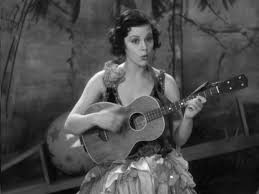
Carl Denham while walking around the port finds the man, described in script notes as a shady Norwegian skipper, named Nils Helstrom who gave him the original map to Skull Island.
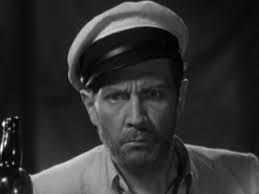
Unknown to Denham is that Helstrom has killed Hilda's father and burned down their little tent show. Knowing he will eventually be arrested for the murder. Helstrom talks his way onto the Venture by making up a story of a treasure on Skull Island. One thing leads to another and both Hilda and Helstrom end up on the Venture with the Norwegian frightening the girl into keeping quiet about her father's death.
By the time the Venture arrives at Skull Island. The film has been anything but funny as Ruth Rose stated. Besides the murder of her father and Hilda without any means of support. We've seen Helstrom attempting to get the new crew to mutiny so he can take over the Venture. Denham, the Captain, Hilda and the crew being driven away by the natives who blame the two men for destroying their village and the many deaths from King Kong. In fact the film's only funny moments, so far, came from the monkey's in Hilda's fathers show and we are already more than halfway through the motion picture.
However, enter the comedian in chief the "Son of Kong". Who is friendly like a human toddler and is injured fighting a cave bear to protect Carl and Hilda. It is then up to Carl Denham, the man who killed his father, to render first aide with Hilda's help. "Little Kong" as Denham has named him keeps showing up bothering Carl Denham in small comic sketches.
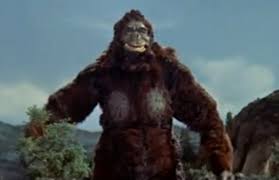
Now look at the above photo of the new Japanese King Kong from "King Kong Escapes". Although you can still see the problems with an actor in a suit being a believable giant gorilla, note the left arm were the material gathers, it appears Eiji Tsuburaya and his team were able to get over their problems with the first King Kong suit. Also this Kong is only just short of 66 feet tall.
The story starts one month after King Kong and we find Carl Denham and Captain Inglehorn in legal troubles. The two escape their creditors on the Venture, still owned for the moment by the Captain, to become cargo shippers in the South Seas. The only other character from the original film in this feature is Charlie the Cook.
Eventually the Venture arrives at a Dutch port where they see a small animal show with trained monkey's, joke here about King Kong from Denham, and a young women named Hilda, She is played by Helen Mack who sings a song very badly below.
Carl Denham while walking around the port finds the man, described in script notes as a shady Norwegian skipper, named Nils Helstrom who gave him the original map to Skull Island.
Unknown to Denham is that Helstrom has killed Hilda's father and burned down their little tent show. Knowing he will eventually be arrested for the murder. Helstrom talks his way onto the Venture by making up a story of a treasure on Skull Island. One thing leads to another and both Hilda and Helstrom end up on the Venture with the Norwegian frightening the girl into keeping quiet about her father's death.
By the time the Venture arrives at Skull Island. The film has been anything but funny as Ruth Rose stated. Besides the murder of her father and Hilda without any means of support. We've seen Helstrom attempting to get the new crew to mutiny so he can take over the Venture. Denham, the Captain, Hilda and the crew being driven away by the natives who blame the two men for destroying their village and the many deaths from King Kong. In fact the film's only funny moments, so far, came from the monkey's in Hilda's fathers show and we are already more than halfway through the motion picture.
However, enter the comedian in chief the "Son of Kong". Who is friendly like a human toddler and is injured fighting a cave bear to protect Carl and Hilda. It is then up to Carl Denham, the man who killed his father, to render first aide with Hilda's help. "Little Kong" as Denham has named him keeps showing up bothering Carl Denham in small comic sketches.
The final events of the movie come fast from this point forward as Cooper was instructed to keep the overall running time down by RKO. There turns out to be a real treasure found with the help of "Little Kong'", The Venture's crew does mutiny, but they also cast Nils Helstrom off in a small boat and he is killed by the Centiosaurus.
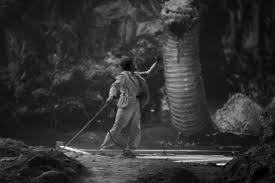
Suddenly Skull Island is rocked with earthquakes and begins to fall apart and sink. Hilda, Englehorn and Charlie are attempting to escape in the lifeboat they came ashore in originally. Denham is trapped on the island, but Kong's son saves him while sacrificing his own life. Cue the tears from the audience.
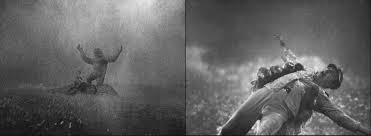
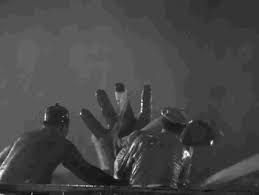
Of course in 1933 American newspaper advertising wasn't much help on size..

EDO NI ARAWARETA KINGU KONGU (1938)
"King Kong Appears in Edo" was a two part silent motion picture made by Zensho Cinema in Japan. Part One: "King Kong Appear in Edo: The Episode of Transformation" premiered on March 31, 1938 and Part Two: "King Kong Appears in Edo: The Episode of Gold" on April 7, 1938. Like many Japanese films made prior to the start of World War 2. This picture is considered "Lost" as a result of the American bombings of the island.
For those unfamiliar with the city of Edo. Today it is called Tokyo.
For decades this movie had been only a rumor and it was thought not to have ever existed. However, this was to change as time passed when first posters of the motion picture were found.

Additionally it was discovered that special effects wizard Fuminori Ohashi not only designed the creature for the film, but played it. The website Wikizilla has a good overview of the picture which includes a brief description of the story of each part at:
http://godzilla.wikia.com/wiki/King_Kong_Appears_in_Edo_(1938_film)
It also contains this now often quoted quotation from Ohashi:
As Wikizilla points out that 32 second YouTube video alleged to be found footage from this film is fake. For one the creature does not look like the one designed and worn by Fuminori Ohashi, but a man in a part gorilla suit and an almost clean face. Below is an image from that video to compare with the above actual posters showing Ohashi's creation he wore.

Although Merian C. Cooper and Ernest B. Schoedack produced 1949's "Mighty Joe Young". Which was stop motion animated by the team of O'Brien and Delgado. Along with a young man named Ray Harryhauseen. The character of "King Kong' would not be seen again until 1962 and then also from Japan.
KINGU KONGU TAI GOJIRA (1962)
To begin with "King Kong vs Godzilla" wasn't supposed to be a movie with King Kong in it. Although it is said that Eiji Tsuburaya had suggested a similar idea much earlier. At the time of script development the Toho Studio team were leaning towards Mosura (Mothra) as the original motion picture had been a big hit in the United States and would make their picture salable outside of Japan and Asia.
Then American producer John Beck appeared. Beck had come up with a plan to appeal to both Japanese and American audiences with a potentially guaranteed money making film for himself and Toho. He had in his possession a screenplay written originally by Willis O'Brien and rewritten at Beck's direction by George Worthington Yates. This redesigned picture would finally bring back the name "Godzilla" to the United States and other English speaking countries. As the 1955 sequel had been re-edited, dubbed and released as a non-Gojira movie in 1959 with the title "Gigantis, the Fire Monster".
For those of my readers that want a detailed story of the Americanization of Gojira. This link takes you to my article: "Turning "Gojira" into "Godzilla" covering the English language versions of the first three motion pictures.
http://www.bewaretheblog.com/2016/09/the-americanization-of-gojira-at-start.html
What would result from this partnership of John Beck and Toho Studios were two different movies, but made from the same original story. I am not going to go into the back story of the motion picture, or the differences. Which I have already covered in the article at the above link, but instead just look at the Japanese "King Kong" character.
The color of an animal is important in a motion picture filmed in that format to maintain a semblance of reality.
There has been an on going debate as to what color Godzilla was suppose to be in the two black and white originals from 1954 and 1955. On any of the original Japanese posters Gojira is dark grey in color.
Suddenly Skull Island is rocked with earthquakes and begins to fall apart and sink. Hilda, Englehorn and Charlie are attempting to escape in the lifeboat they came ashore in originally. Denham is trapped on the island, but Kong's son saves him while sacrificing his own life. Cue the tears from the audience.
Of course in 1933 American newspaper advertising wasn't much help on size..

EDO NI ARAWARETA KINGU KONGU (1938)
"King Kong Appears in Edo" was a two part silent motion picture made by Zensho Cinema in Japan. Part One: "King Kong Appear in Edo: The Episode of Transformation" premiered on March 31, 1938 and Part Two: "King Kong Appears in Edo: The Episode of Gold" on April 7, 1938. Like many Japanese films made prior to the start of World War 2. This picture is considered "Lost" as a result of the American bombings of the island.
For those unfamiliar with the city of Edo. Today it is called Tokyo.
For decades this movie had been only a rumor and it was thought not to have ever existed. However, this was to change as time passed when first posters of the motion picture were found.

Additionally it was discovered that special effects wizard Fuminori Ohashi not only designed the creature for the film, but played it. The website Wikizilla has a good overview of the picture which includes a brief description of the story of each part at:
http://godzilla.wikia.com/wiki/King_Kong_Appears_in_Edo_(1938_film)
It also contains this now often quoted quotation from Ohashi:
The first model to be counted as "special art direction" in Japanese cinema was a giant gorilla I did for the movie King Kong Appears in Edo fifty years ago. It was also the first movie to feature certain kinds of special effects.For those unfamiliar with the name Fuminori Ohashi. Among his non-screen acknowledged work under Eiji Tsuburaya were the design and construction of the suit for the 1954 "Gojira" and the one's used in "King Kong vs Godzilla". Ohashi's wide variety of creative ideas includes working on the designs for some of the attractions for Walt Disney's original "Disneyland" Park in Anaheim, California and the masks used in the original 1968 "Planet of the Apes".
As Wikizilla points out that 32 second YouTube video alleged to be found footage from this film is fake. For one the creature does not look like the one designed and worn by Fuminori Ohashi, but a man in a part gorilla suit and an almost clean face. Below is an image from that video to compare with the above actual posters showing Ohashi's creation he wore.

Although Merian C. Cooper and Ernest B. Schoedack produced 1949's "Mighty Joe Young". Which was stop motion animated by the team of O'Brien and Delgado. Along with a young man named Ray Harryhauseen. The character of "King Kong' would not be seen again until 1962 and then also from Japan.
KINGU KONGU TAI GOJIRA (1962)
To begin with "King Kong vs Godzilla" wasn't supposed to be a movie with King Kong in it. Although it is said that Eiji Tsuburaya had suggested a similar idea much earlier. At the time of script development the Toho Studio team were leaning towards Mosura (Mothra) as the original motion picture had been a big hit in the United States and would make their picture salable outside of Japan and Asia.
Then American producer John Beck appeared. Beck had come up with a plan to appeal to both Japanese and American audiences with a potentially guaranteed money making film for himself and Toho. He had in his possession a screenplay written originally by Willis O'Brien and rewritten at Beck's direction by George Worthington Yates. This redesigned picture would finally bring back the name "Godzilla" to the United States and other English speaking countries. As the 1955 sequel had been re-edited, dubbed and released as a non-Gojira movie in 1959 with the title "Gigantis, the Fire Monster".
For those of my readers that want a detailed story of the Americanization of Gojira. This link takes you to my article: "Turning "Gojira" into "Godzilla" covering the English language versions of the first three motion pictures.
http://www.bewaretheblog.com/2016/09/the-americanization-of-gojira-at-start.html
What would result from this partnership of John Beck and Toho Studios were two different movies, but made from the same original story. I am not going to go into the back story of the motion picture, or the differences. Which I have already covered in the article at the above link, but instead just look at the Japanese "King Kong" character.
The color of an animal is important in a motion picture filmed in that format to maintain a semblance of reality.
There has been an on going debate as to what color Godzilla was suppose to be in the two black and white originals from 1954 and 1955. On any of the original Japanese posters Gojira is dark grey in color.
But we American's always knew that sea monsters were green and the posters advertising the 1956 re-edit confirmed that belief..As a means for young and old audiences to imagine Godzilla that way. Even if the movie was filmed in stark black and white.

The posters for 1955's "The Phantom from 10,000 Leagues" had used the same green color for its sea monster in a black and white motion picture.

As had been done three years earlier for 1953's "The Beast from 20,000 Fathoms".

One of the poster's for John Beck's "King Kong vs Godzilla" didn't change the misconception
Although the movie would correct it somewhat.

But we are concerned with King Kong here and all previous motion pictures were filmed in stark black and white. So what color was the 1933 "King Kong"?
The website "Old Hollywood in Color" gives us the answer with this photograph of Willis O'Brien looking at the giant bust of King Kong and it's following still both taken during production of the motion picture.


My reader can find the entire article at:
https://oldhollywoodincolor.com/2011/12/29/on-the-set-with-king-kong/
As Merian C. Cooper knew from personal experience and Willis O'Brien knew from research for the 1933 "King Kong". Gorilla's have a black skin and are normally black in color. Occasionally some males have a grey, or silver back and an albino may also be born. The Japanese King Kong has a reddish tint like an orangutan.Which shows even more red in some sequences.
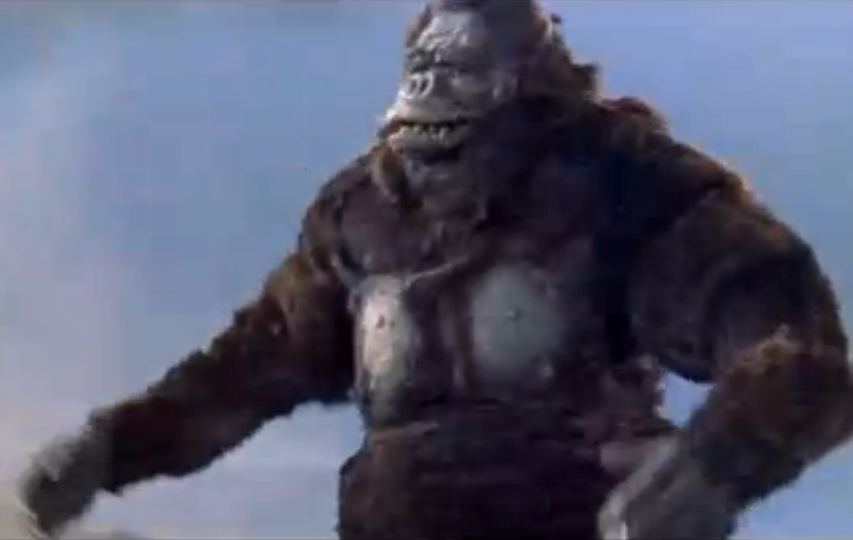
What is interesting is that Universal International, that released the Beck version, doctored some of the lobby cards for the movie. As the one below indicates Godzilla is a bright green while King Kong is now black like a real gorilla without the red tint to his fur..
As for the size of King Kong he had to be close to the height of Godzilla to even stand a chance to win the battle.
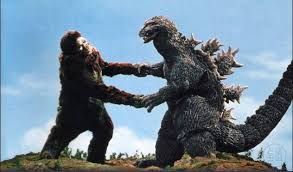
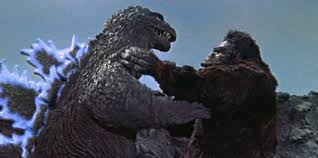
In the feature Godzilla stood at a height of 164 feet which would remain throughout the Showa Era. As to his opponent King Kong he was supposed to be at a height of 147 feet. At least in most of the picture.
There are many who rightly complain about the look of the Japanese Kong. Unlike making a stop motion model that can be sculptured to look like a real gorilla. Toho Studios had to create a suit for an actor to wear and suggest a real gorilla. It just didn't work as has happened with many motion picture gorilla costumes since silent films.
I always found this lack of care on the look of the King Kong costume as surprising, because back in 1955 with "Mountain Snowman" I thought Eiji Tsuburaya and his team did an excellent Abominable Snowman suitmation costume.
In this still from the original Japanese version of what became a shameful American re-edit three years later called "Half-Human". Both the adult and his son look fierce even though they are not unless provoked.
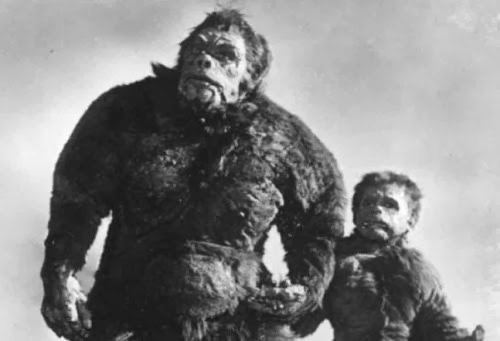
While King Kong looks overweight for a gorilla with only a suggestive body type and just plain, can't put it any other way, stupid. My reader should note the difference in the faces from the two motion picture of what in reality are very similar costume constructions.

The following two close-ups of King Kong's face look too static and in no way as realistic as the one's imagined for "Mountain Snowman" seven years before. In fact they almost seem comical in design. Not helping the idea that he can stand up to Godzilla. One has to wonder if part of the difference was caused by needing to create a color King Kong, or had to do with the concept for the original Japanese version I discuss in detail at the above link.
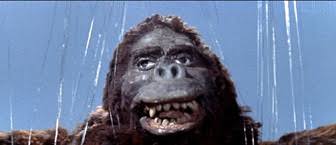

Both film versions have the same basic plot line. However, Toho's uses it to parody the changes in Japanese Business Models to American. While John Beck, by adding American actors and scenes from "The Mysterians", attempts to change the Toho original into a typical American Giant Monster on the loose motion picture.
Godzilla reappears and starts attacking Japan. Meanwhile at the Pacific pharmaceutical company the owner learns of a special type of Red Berry with special medical properties They are found only on Faro Island, not Skull Island, and the owner sends two men to bring some back to him. Also there is supposed to be a monster God and for publicity purposes the owner of Pacific Pharmaceutical's wants it too.
This leads to the discovery of King Kong, his capture and eventually a series of fights between the gorilla and Godzilla. Mie Hama plays Fumiko Sakurai. Can you say the Japanese first version of Ann Darrow? Here is Toho's version of Kong holding Ann.

At least the size ratio works better in this film for this sequence. Although in the above left shot Kong is holding a doll. On the right Mie Hama is in the giant hand just as Fay Wray was in the 1933 original.

In "King Kong vs Godzilla" there was no Empire State Building for Kong to climb with Hama. So the "DIET" building takes its place. Only problem is the Diet is about 214 feet tall as compared to the 1,250 foot Empire State Building, or a 147 foot tall Kong.
What results is a laughable scene of King Kong on top of the Diet holding the doll that is suppose to be Mie Hama. In fact this scene is of a model Diet and a puppet King Kong.

Below the suitmation King Kong approaches the Diet Building. Note how the actor is probably as tall as the model Diet. Showing that it wasn't only the 1933 Kong that was having size issues, but the Japanese one as well. In the scene the Mia Hama doll is put down by King Kong and then we have the problem of superimposing the actress to size in front of the model.

The feature was a success and led to Toho making "Mothra vs Godzilla" for release in 1964 and not the planned rematch. This change was a result of law suits over the use of the name and image of King Kong. This first came from Willis O'Brien and then his Estate with the Estate of Merian C. Cooper. All over John Beck's illegal use of the original Willis O'Brien screenplay.
.
KINGU KONGU NO GYAKUSHU (1967)
1967'S "King Kong's Counterattack" aka: "King Kong Escapes" was a co-production of Toho Studios and the American animation company Rankin/Bass loosely based upon their cartoon program "The King Kong Show".


Both in the cartoon series and the Toho motion picture the villain of the piece is an evil scientist named "Dr. Who". The names causing confusion with the BBC series about the "Time Lord". In the cartoon he is described as"
In the motion picture version he became a Chinese evil scientist played by actor Hideyo Amomoto. His name is written as "Dr. Hu".

In the cartoon series King Kong lives on "Mondo Island" which is the same name used for the island in the motion picture. At times during the 25 episode cartoon series the island is referred to as "Skull Island". The show followed the adventures of the "Bond" family. The family consisted of a father who is a Professor, a daughter and a son. The daughter's name is Susan. Which happens to be the first name of Lt. Susan Watson played by Linda Miller in the motion picture. One character in the cartoon series, but not the motion picture is from the original 1933 film "Captain Englehorn". He is in charge of Professor Bond's ship.
Another major character invented by "Dr. Who" in the cartoon series is "Mecha-Kong". Which also appears to challenge King Kong in the motion picture.
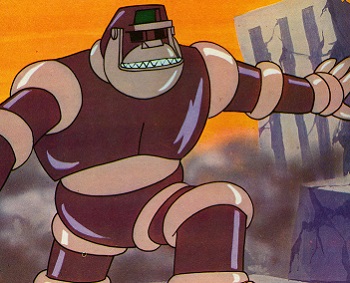

The basic plot line of the motion picture has Dr. Hu working for an unknown country. Can you say North Korea? He invents Mecha-Kong to dig for Element X which is so radioactive that a human would die instantly from its properties. Overseeing the work is the evil and lovely Madam Piranha. I love that name and the actress portraying her. Once again it is Mie Hama both seductive and pure evil. Fresh from the James Bond feature "You Only Live Twice".
The movies plot is very simple,because of engine trouble a NATO submarine stops off of Mondo island and three members of the crew, Commander Carl Nelson, Lt. Commander Jiro Nomura and Lt. Susan Watson, go on shore to discover King Kong. Returning to the original 1933 feature there is a fight between King Kong and Gorosaurus instead of the Tyrannosaurus. There is also a fight with a snake like creature in the sea and not a cave.
Again like Fay Wray we have King Kong falling for Lt. Susan Watson. This plot device will lead eventually to the film's climax on the Tokyo Tower, substituting for the Empire State Building, as King Kong does battle with Mecha-Kong to protect Susan.
Below is the poster for the American release of the motion picture.

The artist for the above poster portrays Mecha-Kong perfectly, but King Kong is drawn more like a realistic gorilla full of rage in his fight. So what did this version of the Japanese King Kong look like?
There were some major changes in his features and as the picture was based upon a cartoon series. The look of Kong could be a little more friendly. Below is first a picture of Toho's original King Kong and the second picture shows King Kong as he appeared in this motion picture.
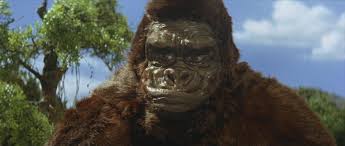

Obviously those in English speaking countries expected something different in appearance based upon the above poster.
The second King Kong suit's proportions are different than the original and his hair is darker. Additionally he appears a lot more gorilla like in appearance except for that face.
Below once again the full view of King Kong in "King Kong vs Godzilla".

The posters for 1955's "The Phantom from 10,000 Leagues" had used the same green color for its sea monster in a black and white motion picture.

As had been done three years earlier for 1953's "The Beast from 20,000 Fathoms".

One of the poster's for John Beck's "King Kong vs Godzilla" didn't change the misconception
Although the movie would correct it somewhat.
But we are concerned with King Kong here and all previous motion pictures were filmed in stark black and white. So what color was the 1933 "King Kong"?
The website "Old Hollywood in Color" gives us the answer with this photograph of Willis O'Brien looking at the giant bust of King Kong and it's following still both taken during production of the motion picture.


My reader can find the entire article at:
https://oldhollywoodincolor.com/2011/12/29/on-the-set-with-king-kong/
As Merian C. Cooper knew from personal experience and Willis O'Brien knew from research for the 1933 "King Kong". Gorilla's have a black skin and are normally black in color. Occasionally some males have a grey, or silver back and an albino may also be born. The Japanese King Kong has a reddish tint like an orangutan.Which shows even more red in some sequences.

What is interesting is that Universal International, that released the Beck version, doctored some of the lobby cards for the movie. As the one below indicates Godzilla is a bright green while King Kong is now black like a real gorilla without the red tint to his fur..
As for the size of King Kong he had to be close to the height of Godzilla to even stand a chance to win the battle.
In the feature Godzilla stood at a height of 164 feet which would remain throughout the Showa Era. As to his opponent King Kong he was supposed to be at a height of 147 feet. At least in most of the picture.
There are many who rightly complain about the look of the Japanese Kong. Unlike making a stop motion model that can be sculptured to look like a real gorilla. Toho Studios had to create a suit for an actor to wear and suggest a real gorilla. It just didn't work as has happened with many motion picture gorilla costumes since silent films.
I always found this lack of care on the look of the King Kong costume as surprising, because back in 1955 with "Mountain Snowman" I thought Eiji Tsuburaya and his team did an excellent Abominable Snowman suitmation costume.
In this still from the original Japanese version of what became a shameful American re-edit three years later called "Half-Human". Both the adult and his son look fierce even though they are not unless provoked.

While King Kong looks overweight for a gorilla with only a suggestive body type and just plain, can't put it any other way, stupid. My reader should note the difference in the faces from the two motion picture of what in reality are very similar costume constructions.
The following two close-ups of King Kong's face look too static and in no way as realistic as the one's imagined for "Mountain Snowman" seven years before. In fact they almost seem comical in design. Not helping the idea that he can stand up to Godzilla. One has to wonder if part of the difference was caused by needing to create a color King Kong, or had to do with the concept for the original Japanese version I discuss in detail at the above link.
Both film versions have the same basic plot line. However, Toho's uses it to parody the changes in Japanese Business Models to American. While John Beck, by adding American actors and scenes from "The Mysterians", attempts to change the Toho original into a typical American Giant Monster on the loose motion picture.
Godzilla reappears and starts attacking Japan. Meanwhile at the Pacific pharmaceutical company the owner learns of a special type of Red Berry with special medical properties They are found only on Faro Island, not Skull Island, and the owner sends two men to bring some back to him. Also there is supposed to be a monster God and for publicity purposes the owner of Pacific Pharmaceutical's wants it too.
This leads to the discovery of King Kong, his capture and eventually a series of fights between the gorilla and Godzilla. Mie Hama plays Fumiko Sakurai. Can you say the Japanese first version of Ann Darrow? Here is Toho's version of Kong holding Ann.

At least the size ratio works better in this film for this sequence. Although in the above left shot Kong is holding a doll. On the right Mie Hama is in the giant hand just as Fay Wray was in the 1933 original.

In "King Kong vs Godzilla" there was no Empire State Building for Kong to climb with Hama. So the "DIET" building takes its place. Only problem is the Diet is about 214 feet tall as compared to the 1,250 foot Empire State Building, or a 147 foot tall Kong.
What results is a laughable scene of King Kong on top of the Diet holding the doll that is suppose to be Mie Hama. In fact this scene is of a model Diet and a puppet King Kong.

Below the suitmation King Kong approaches the Diet Building. Note how the actor is probably as tall as the model Diet. Showing that it wasn't only the 1933 Kong that was having size issues, but the Japanese one as well. In the scene the Mia Hama doll is put down by King Kong and then we have the problem of superimposing the actress to size in front of the model.

The feature was a success and led to Toho making "Mothra vs Godzilla" for release in 1964 and not the planned rematch. This change was a result of law suits over the use of the name and image of King Kong. This first came from Willis O'Brien and then his Estate with the Estate of Merian C. Cooper. All over John Beck's illegal use of the original Willis O'Brien screenplay.
.
KINGU KONGU NO GYAKUSHU (1967)
1967'S "King Kong's Counterattack" aka: "King Kong Escapes" was a co-production of Toho Studios and the American animation company Rankin/Bass loosely based upon their cartoon program "The King Kong Show".

Both in the cartoon series and the Toho motion picture the villain of the piece is an evil scientist named "Dr. Who". The names causing confusion with the BBC series about the "Time Lord". In the cartoon he is described as"
a bald big-brained and bespectacled mad scientist who wants to capture Kong for his evil experiments.
In the motion picture version he became a Chinese evil scientist played by actor Hideyo Amomoto. His name is written as "Dr. Hu".
In the cartoon series King Kong lives on "Mondo Island" which is the same name used for the island in the motion picture. At times during the 25 episode cartoon series the island is referred to as "Skull Island". The show followed the adventures of the "Bond" family. The family consisted of a father who is a Professor, a daughter and a son. The daughter's name is Susan. Which happens to be the first name of Lt. Susan Watson played by Linda Miller in the motion picture. One character in the cartoon series, but not the motion picture is from the original 1933 film "Captain Englehorn". He is in charge of Professor Bond's ship.
Another major character invented by "Dr. Who" in the cartoon series is "Mecha-Kong". Which also appears to challenge King Kong in the motion picture.

The basic plot line of the motion picture has Dr. Hu working for an unknown country. Can you say North Korea? He invents Mecha-Kong to dig for Element X which is so radioactive that a human would die instantly from its properties. Overseeing the work is the evil and lovely Madam Piranha. I love that name and the actress portraying her. Once again it is Mie Hama both seductive and pure evil. Fresh from the James Bond feature "You Only Live Twice".
The movies plot is very simple,because of engine trouble a NATO submarine stops off of Mondo island and three members of the crew, Commander Carl Nelson, Lt. Commander Jiro Nomura and Lt. Susan Watson, go on shore to discover King Kong. Returning to the original 1933 feature there is a fight between King Kong and Gorosaurus instead of the Tyrannosaurus. There is also a fight with a snake like creature in the sea and not a cave.
Again like Fay Wray we have King Kong falling for Lt. Susan Watson. This plot device will lead eventually to the film's climax on the Tokyo Tower, substituting for the Empire State Building, as King Kong does battle with Mecha-Kong to protect Susan.
Below is the poster for the American release of the motion picture.

The artist for the above poster portrays Mecha-Kong perfectly, but King Kong is drawn more like a realistic gorilla full of rage in his fight. So what did this version of the Japanese King Kong look like?
There were some major changes in his features and as the picture was based upon a cartoon series. The look of Kong could be a little more friendly. Below is first a picture of Toho's original King Kong and the second picture shows King Kong as he appeared in this motion picture.
Obviously those in English speaking countries expected something different in appearance based upon the above poster.
The second King Kong suit's proportions are different than the original and his hair is darker. Additionally he appears a lot more gorilla like in appearance except for that face.
Below once again the full view of King Kong in "King Kong vs Godzilla".
Now look at the above photo of the new Japanese King Kong from "King Kong Escapes". Although you can still see the problems with an actor in a suit being a believable giant gorilla, note the left arm were the material gathers, it appears Eiji Tsuburaya and his team were able to get over their problems with the first King Kong suit. Also this Kong is only just short of 66 feet tall.
Additionally the movies screenplay was deliberately cartoonish from it's source and a realistic King Kong might have actually distracted from the story.
Of course we can't have a King Kong movie without Ann Darrow, oops, Lt. Susan Watson in his hand.


The motion picture ends with Dr. Hu, Madam Piranha and Mecha-Kong defeated. King Kong says goodbye to his human friends and starts to swim back to Mondo Island as King Kong in the previous picture was seen swimming back to Faro.
KING KONG (1976)
The Dino De Laurentiis screenplay is a hybrid combination of 1933 and 1962. It goes back to Toho's original screenplay for "King Kong vs Godzilla" that was a parody of the changing business practices in Japan. Replacing that idea with an attack on the practices of American Big Oil in the 1970's. Making the underlying story very timely to the newspaper headlines the picture's viewing audience was reading about, or watching on television news programs.
The basic story has representatives of the Petrox Oil Company, under Charles Grodin's Fred Wilson, leaving on the Petrox Explorer to find a previously unknown island in the Indian Ocean. The island has never been seen, because it is covered in a never moving cloud bank. OK, climatologists that's a physical impossibility, but this is a Hollywood movie. Infra red satellite imagery had revealed large deposits of oil on the island.
The crew discovers a stow-a-way Paleontologist Jack Prescott, Jeff Bridges, who brings a dire warning about the island and the possibility of a monster God. At sea they pick up our Ann Darrow substitute a girl named Dawn who changed her name to Dwan portrayed by Jessica Lange.

The movie also substitutes for the Empire State Building, because at the time the largest buildings in New York were the Twin Towers. The above poster of course exaggerates the size of Kong by having one foot on each of the two towers.
Here we go again with size versus scene. When the crew of the Petrox Explorer is on Skull island King Kong is scaled at 42 feet in height. When he's in New York City he must have taken a few vitamins on the voyage over. As he has grown another 13 feet to 55 feet in height.
Originally there's was talk about making the movie in Stop Motion, but this was dropped for an actor in a costume. Rick Baker was to design the suit,but had to work with Italian special effects maker Carlo Rimbaldi. Rimbaldi would win three Academy Awards for Best Visual Effects, One for this motion picture, one for "E.T. the Extra-Terrestrial" and one for "Alien".
The resulting suit was not to Baker's expectations. He blamed Carlo Rambaldi for what he considered a disappointing look to his King Kong costume, but credited him for the success of the large mechanical Kong mask and the facial expressions they were able to get from it.


Jessica Lang was seen in that mandatory girl in distress in the hand of King Kong sequence.

The above two scenes are of the 42 foot version of King Kong and would ask the question, once again, of what size did the 1933 have to be to hold Fay Wray? Compare the pictures of Lang and Wray above..
As I mentioned at the start of this section. The picture took on the American Oil Industry, if you were not living in the United States at the time you may miss the point here.
In the 1970's America was in the middle of a gasoline promotional war between the Big Oil Companies for our dollars. This reminded me of the "Gas Wars" my Uncle's Gas Station was involved in during the first half of the 1950's when regular was 20 cents a galleon. There was a different oil company gas station on each of the four corners of almost every major intersection completing for business. The problem was gas prices were always the same at each station. They never competed with the price. So they came up with free merchandise to lure a person in. Fill the tank up and you might get a carton of cigarettes, or a place setting of Melmac Dinnerware made from colorful plastic. The source of the name for the alien "ALF's" home planet on the 1986 Television show. Implying it was plastic and boring.
In the movie instead of presenting King Kong on a New York Theater's stage as in the 1933 original. In this film he was presented as a promotional gimmick to buy Pretrox Gasoline over their competitors. The result is the same though. Kong escapes and creates panic in the streets of New York.


The ending of this movie has King Kong claiming the south towers of the World Trade Center with Dwan. Jack had called the mayor's office to tell them that Kong would be going for the towers, because they resembled the mountains of his own world.
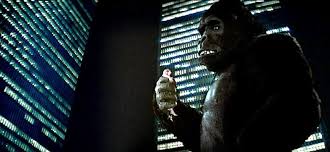
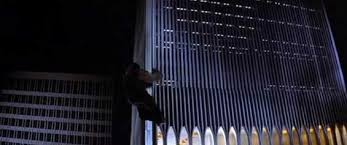
Military helicopter gun ships attack Kong and eventually he falls off the tower 1,362 feet to the ground below. The movie seems to have a bad reputation, but its not as bad as some people say and when it originally came out made three times the total cost of production worldwide.
KING KONG LIVES (1986)
This Dino De Laurentiis sequel to his 1976 motion picture had one small problem to overcome. It came out in 1986 ten years later, but directly followed his first film. The explanation was that King Kong was not killed by all the bullets fired into him, or the fall from the top of the 1,3621 foot south tower. Kong has been in a ten year coma in a special facility in Atlanta, Georgia. He must have had a good health care plan with a zero co-pay.

The movie is terrible and lost just under 14 million dollars of its original 18 million dollar budget. The picture features three Kong costumes. One was the original Rick Baker being reused by Carlo Rambaldi and his staff. Actually at the beginning of the picture there are scenes from the ending of the 1976 movie with Baker as King Kong. Then he is replaced by Peter Elliott for the new film footage. Playing "Lady Kong" is George Yiasomi (George Antoni) and "Baby" Kong is played by Benjamin Kechley.
As to the size of King Kong and his Lady. Lady Kong is 50 feet tall. On the other hand as in 1976 where he grew from 42 feet to 55 feet. Kong must have been fed some more vitamins during his coma. As he gained 5 more feet and was now 60 feet tall.
The screenplay tells the audience that King Kong's heart needs replacing and enter Linda Hamilton as Dr. Amy Franklin. She invents a giant artificial heart, but the problem develops that Kong needs a blood transfusion. On cue enter Brian Kerwin as "adventurer" Hank Mitchell. He has captured a giant female gorilla in Boreno that is dubbed "Lady Kong".
Dr. Franklin performs the transplant and the two gorilla's fall in love. Franklin and Mitchell also fall in love. The gorilla's will have a baby, but Franklin and Mitchell will not.
The two gorilla's escape and an insane, naturally, army colonel goes after the gorillas.

"Lady Kong" is captured while King Kong falls off a cliff and is mistakenly thought to be dead. He isn't and attempts to rescues his true love who has been discovered to be pregnant., King Kong is finally killed, as is the insane army colonel, during the rescue. Dr. Franklin and Mitchell take "Lady Kong" to Boreno where she and King Kong's son live happily ever after.
Of course the two screenplay writers never address the side issue. That if there is one giant gorilla in Borneo. There most be parents and therefore a whole group making the idea of King Kong as this powerful Skull Island God not so big a deal.
KING KONG (2005)
Peter Jackson re-envisioned Merian C. Cooper's original 1933 motion picture in 2005. One thing he had going for him, or may not was CGI from the New Zealand based WETA workshop.

WETA used motion capture and Andy Serkis portrayed King Kong and his facial emotions and actions were transferred to the Computer Generated Imagery of Kong.

Technology had finally met the "King", but this was a fantasy film and there were some viewers and critics who believed Kong looked too real. That reality killed the Beast not Beauty, As the audience was in awe of what Serkis and Peter Jackson had created rather than the fantasy of the Beauty and the Beast tale.
However you view the look of King Kong in the film. The Academy of Motion Pictures Arts and Sciences gave the film the Oscar for Visual Effects.
As to the height question this King Kong was set at 25 feet throughout the production. Using CGI for buildings and other backdrops helped WETA maintain the size ratio.
The following picture reflects a 40 foot Tyrannosaurus bending down to look eye to eye with the 15 feet smaller King Kong. Here 2005 CGI does win out over the Stop Motion of 1933, because as I just said the images size ratio can be maintained.

The plot is basically a period piece recreation of the original 1933 story which slight character changes. Film critic Ian Spelling in a December 2005 with Peter Jackson for SciFi.com noted, as did actor Jack Black apparently, that Carl Denham resembled actor/director Orson Wells.
I presume this was how the character was approached in this film, because in the 1933 original. Carl Denham was recognized by any person who knew Merian C. Cooper as Cooper himself. Again I suggest my reader go to my biography on the producer, director I referenced above.
Ann Darrow is pretty much a straight forward copy of the original character. This includes some of the same scenes such as her stealing an apple and Denham stepping in to get her out of trouble.
Jack Driscoll is a change. He is no longer the First Mate of the "Venture", but a screenplay writer. He is delivering a script to Carl Denham, becomes delayed and finds himself on the voyage to Skull Island.
Captain Engelhorn is not a friend of Denham's as in the original. Instead he dislikes the man, because of the producer/director's obsessive nature. Especially over the legend of Kong and fears he will get people killed.
This screenplay adds more characters and subplots to the voyage. Expect for a jungle more in line with "Jurassic Park" giving WETA a change to show off their work. The story progresses pretty much like the original motion picture.
Which brings us to Ann Darrow being taken and that mandatory scene of her in King Kong's hand.
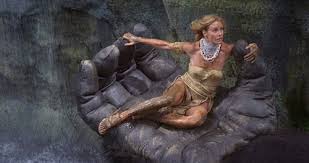
Take a look at this shot of King Kong walking in a normal gorilla posture. The top of his head reaches the second story which would make him about 25 feet tall as this is a commercial building where the first floor is usually designed larger.
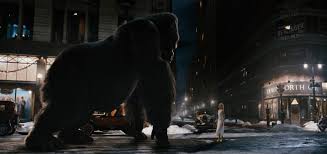
So the question to my reader is how tall is King Kong in the following still with him standing on his two rear legs, if at his tallest he is suppose to be 25 feet?
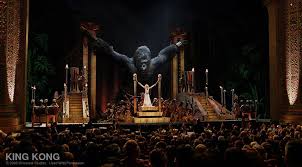
The film ends as the original with King Kong escaping from the above scene. Roaming New York, finding Ann, climbing the Empire State Building and falling to his death with Carl Denham saying the immortal line:
Of note is that in the original 1933 film the pilot and co-pilot of the plane that finally shoots Kong off the Empire State Building were Merian C. Cooper and Ernest B. Schoedsack. In this motion picture it was Peter Jackson and Rick Baker.
Below is my limited edition 1,147 of 3,000 of Kong and Ann made by WETA.
SO HOW MUCH SCREEN TIME THAT THE TITLE CHARACTER GET?
The following chart looks at the three American movies entitled "King Kong" Over the 72 years between the 1933 and 2005 versions of the story. The running time of the picture increased by 82 minutes. However, the percentage of the motion picture King Kong was seen on screen remained at 35 percent. Except for 2005 when it decreased to 33 percent even though Kong was on screen the longest amount of time 61 minutes.

It appears that "Kong: Skull Island" held to the on screen time of the other films and perhaps a little less, because as with Legendary Picture's 2014 "Godzilla". Like the "MUTO'S" in that feature the "Skullcrawler's" of this film have more screen time. Plus there are the flying "Leafwings" to lessen Kong's appearances in this 118 minute motion picture.
After having read this article my reader might not agree with the film's director Jordon Vogt-Roberts who told "The Hollywood Reporter" on June 20, 2016 that:

The basic plot of "Kong: Skull Island" has a group of soldiers fresh out of the Vietnam in 1973 going on an expedition. They're led by at times psychotic Samuel L. Jackson. What only the three behind the expedition, John Goodman, Corey Hawkins and Tian Jing, know. Is that this is backed by the secret government agency "MONARCH" we met in the 2014 "Godzilla" and they expect monsters.
Along for the ride, or in his case the cash is an ex-MI-16 agent played by Tom Hiddleston who becomes Bruce Cabot's Jack Driscoll. Also a photographer played by Brie Larson who is not Fay Wray's Ann Darrow and can not only keep up with the men, but kick ass along the way. Over the length of the film they become the love interest and Kong's friends.
The film is a great twist on the 1933 original and a set up for an upcoming rematch of "King Kong vs Godzilla".
Of course we can't have a King Kong movie without Ann Darrow, oops, Lt. Susan Watson in his hand.
The motion picture ends with Dr. Hu, Madam Piranha and Mecha-Kong defeated. King Kong says goodbye to his human friends and starts to swim back to Mondo Island as King Kong in the previous picture was seen swimming back to Faro.
KING KONG (1976)
The Dino De Laurentiis screenplay is a hybrid combination of 1933 and 1962. It goes back to Toho's original screenplay for "King Kong vs Godzilla" that was a parody of the changing business practices in Japan. Replacing that idea with an attack on the practices of American Big Oil in the 1970's. Making the underlying story very timely to the newspaper headlines the picture's viewing audience was reading about, or watching on television news programs.
The basic story has representatives of the Petrox Oil Company, under Charles Grodin's Fred Wilson, leaving on the Petrox Explorer to find a previously unknown island in the Indian Ocean. The island has never been seen, because it is covered in a never moving cloud bank. OK, climatologists that's a physical impossibility, but this is a Hollywood movie. Infra red satellite imagery had revealed large deposits of oil on the island.
The crew discovers a stow-a-way Paleontologist Jack Prescott, Jeff Bridges, who brings a dire warning about the island and the possibility of a monster God. At sea they pick up our Ann Darrow substitute a girl named Dawn who changed her name to Dwan portrayed by Jessica Lange.

The movie also substitutes for the Empire State Building, because at the time the largest buildings in New York were the Twin Towers. The above poster of course exaggerates the size of Kong by having one foot on each of the two towers.
Here we go again with size versus scene. When the crew of the Petrox Explorer is on Skull island King Kong is scaled at 42 feet in height. When he's in New York City he must have taken a few vitamins on the voyage over. As he has grown another 13 feet to 55 feet in height.
Originally there's was talk about making the movie in Stop Motion, but this was dropped for an actor in a costume. Rick Baker was to design the suit,but had to work with Italian special effects maker Carlo Rimbaldi. Rimbaldi would win three Academy Awards for Best Visual Effects, One for this motion picture, one for "E.T. the Extra-Terrestrial" and one for "Alien".
The resulting suit was not to Baker's expectations. He blamed Carlo Rambaldi for what he considered a disappointing look to his King Kong costume, but credited him for the success of the large mechanical Kong mask and the facial expressions they were able to get from it.
Jessica Lang was seen in that mandatory girl in distress in the hand of King Kong sequence.
The above two scenes are of the 42 foot version of King Kong and would ask the question, once again, of what size did the 1933 have to be to hold Fay Wray? Compare the pictures of Lang and Wray above..
As I mentioned at the start of this section. The picture took on the American Oil Industry, if you were not living in the United States at the time you may miss the point here.
In the 1970's America was in the middle of a gasoline promotional war between the Big Oil Companies for our dollars. This reminded me of the "Gas Wars" my Uncle's Gas Station was involved in during the first half of the 1950's when regular was 20 cents a galleon. There was a different oil company gas station on each of the four corners of almost every major intersection completing for business. The problem was gas prices were always the same at each station. They never competed with the price. So they came up with free merchandise to lure a person in. Fill the tank up and you might get a carton of cigarettes, or a place setting of Melmac Dinnerware made from colorful plastic. The source of the name for the alien "ALF's" home planet on the 1986 Television show. Implying it was plastic and boring.
In the movie instead of presenting King Kong on a New York Theater's stage as in the 1933 original. In this film he was presented as a promotional gimmick to buy Pretrox Gasoline over their competitors. The result is the same though. Kong escapes and creates panic in the streets of New York.


The ending of this movie has King Kong claiming the south towers of the World Trade Center with Dwan. Jack had called the mayor's office to tell them that Kong would be going for the towers, because they resembled the mountains of his own world.
Military helicopter gun ships attack Kong and eventually he falls off the tower 1,362 feet to the ground below. The movie seems to have a bad reputation, but its not as bad as some people say and when it originally came out made three times the total cost of production worldwide.
KING KONG LIVES (1986)
This Dino De Laurentiis sequel to his 1976 motion picture had one small problem to overcome. It came out in 1986 ten years later, but directly followed his first film. The explanation was that King Kong was not killed by all the bullets fired into him, or the fall from the top of the 1,3621 foot south tower. Kong has been in a ten year coma in a special facility in Atlanta, Georgia. He must have had a good health care plan with a zero co-pay.

The movie is terrible and lost just under 14 million dollars of its original 18 million dollar budget. The picture features three Kong costumes. One was the original Rick Baker being reused by Carlo Rambaldi and his staff. Actually at the beginning of the picture there are scenes from the ending of the 1976 movie with Baker as King Kong. Then he is replaced by Peter Elliott for the new film footage. Playing "Lady Kong" is George Yiasomi (George Antoni) and "Baby" Kong is played by Benjamin Kechley.
As to the size of King Kong and his Lady. Lady Kong is 50 feet tall. On the other hand as in 1976 where he grew from 42 feet to 55 feet. Kong must have been fed some more vitamins during his coma. As he gained 5 more feet and was now 60 feet tall.
The screenplay tells the audience that King Kong's heart needs replacing and enter Linda Hamilton as Dr. Amy Franklin. She invents a giant artificial heart, but the problem develops that Kong needs a blood transfusion. On cue enter Brian Kerwin as "adventurer" Hank Mitchell. He has captured a giant female gorilla in Boreno that is dubbed "Lady Kong".
Dr. Franklin performs the transplant and the two gorilla's fall in love. Franklin and Mitchell also fall in love. The gorilla's will have a baby, but Franklin and Mitchell will not.
The two gorilla's escape and an insane, naturally, army colonel goes after the gorillas.

"Lady Kong" is captured while King Kong falls off a cliff and is mistakenly thought to be dead. He isn't and attempts to rescues his true love who has been discovered to be pregnant., King Kong is finally killed, as is the insane army colonel, during the rescue. Dr. Franklin and Mitchell take "Lady Kong" to Boreno where she and King Kong's son live happily ever after.
Of course the two screenplay writers never address the side issue. That if there is one giant gorilla in Borneo. There most be parents and therefore a whole group making the idea of King Kong as this powerful Skull Island God not so big a deal.
KING KONG (2005)
Peter Jackson re-envisioned Merian C. Cooper's original 1933 motion picture in 2005. One thing he had going for him, or may not was CGI from the New Zealand based WETA workshop.
WETA used motion capture and Andy Serkis portrayed King Kong and his facial emotions and actions were transferred to the Computer Generated Imagery of Kong.

Technology had finally met the "King", but this was a fantasy film and there were some viewers and critics who believed Kong looked too real. That reality killed the Beast not Beauty, As the audience was in awe of what Serkis and Peter Jackson had created rather than the fantasy of the Beauty and the Beast tale.
However you view the look of King Kong in the film. The Academy of Motion Pictures Arts and Sciences gave the film the Oscar for Visual Effects.
As to the height question this King Kong was set at 25 feet throughout the production. Using CGI for buildings and other backdrops helped WETA maintain the size ratio.
The following picture reflects a 40 foot Tyrannosaurus bending down to look eye to eye with the 15 feet smaller King Kong. Here 2005 CGI does win out over the Stop Motion of 1933, because as I just said the images size ratio can be maintained.

The plot is basically a period piece recreation of the original 1933 story which slight character changes. Film critic Ian Spelling in a December 2005 with Peter Jackson for SciFi.com noted, as did actor Jack Black apparently, that Carl Denham resembled actor/director Orson Wells.
I presume this was how the character was approached in this film, because in the 1933 original. Carl Denham was recognized by any person who knew Merian C. Cooper as Cooper himself. Again I suggest my reader go to my biography on the producer, director I referenced above.
Ann Darrow is pretty much a straight forward copy of the original character. This includes some of the same scenes such as her stealing an apple and Denham stepping in to get her out of trouble.
Jack Driscoll is a change. He is no longer the First Mate of the "Venture", but a screenplay writer. He is delivering a script to Carl Denham, becomes delayed and finds himself on the voyage to Skull Island.
Captain Engelhorn is not a friend of Denham's as in the original. Instead he dislikes the man, because of the producer/director's obsessive nature. Especially over the legend of Kong and fears he will get people killed.
This screenplay adds more characters and subplots to the voyage. Expect for a jungle more in line with "Jurassic Park" giving WETA a change to show off their work. The story progresses pretty much like the original motion picture.
Which brings us to Ann Darrow being taken and that mandatory scene of her in King Kong's hand.
Take a look at this shot of King Kong walking in a normal gorilla posture. The top of his head reaches the second story which would make him about 25 feet tall as this is a commercial building where the first floor is usually designed larger.
So the question to my reader is how tall is King Kong in the following still with him standing on his two rear legs, if at his tallest he is suppose to be 25 feet?
The film ends as the original with King Kong escaping from the above scene. Roaming New York, finding Ann, climbing the Empire State Building and falling to his death with Carl Denham saying the immortal line:
It wasn't the airplanes. It was Beauty that killed the Beast..
Of note is that in the original 1933 film the pilot and co-pilot of the plane that finally shoots Kong off the Empire State Building were Merian C. Cooper and Ernest B. Schoedsack. In this motion picture it was Peter Jackson and Rick Baker.
Below is my limited edition 1,147 of 3,000 of Kong and Ann made by WETA.
SO HOW MUCH SCREEN TIME THAT THE TITLE CHARACTER GET?
The following chart looks at the three American movies entitled "King Kong" Over the 72 years between the 1933 and 2005 versions of the story. The running time of the picture increased by 82 minutes. However, the percentage of the motion picture King Kong was seen on screen remained at 35 percent. Except for 2005 when it decreased to 33 percent even though Kong was on screen the longest amount of time 61 minutes.

It appears that "Kong: Skull Island" held to the on screen time of the other films and perhaps a little less, because as with Legendary Picture's 2014 "Godzilla". Like the "MUTO'S" in that feature the "Skullcrawler's" of this film have more screen time. Plus there are the flying "Leafwings" to lessen Kong's appearances in this 118 minute motion picture.
After having read this article my reader might not agree with the film's director Jordon Vogt-Roberts who told "The Hollywood Reporter" on June 20, 2016 that:
This is going to be the biggest Kong there's ever been. Not 10 foot or 30 foot, but a 100-foot ape.Obviously the director never heard of the 147 foot tall Japanese King Kong who fought Godzilla in 1962, or he is dismissing it.

The basic plot of "Kong: Skull Island" has a group of soldiers fresh out of the Vietnam in 1973 going on an expedition. They're led by at times psychotic Samuel L. Jackson. What only the three behind the expedition, John Goodman, Corey Hawkins and Tian Jing, know. Is that this is backed by the secret government agency "MONARCH" we met in the 2014 "Godzilla" and they expect monsters.
Along for the ride, or in his case the cash is an ex-MI-16 agent played by Tom Hiddleston who becomes Bruce Cabot's Jack Driscoll. Also a photographer played by Brie Larson who is not Fay Wray's Ann Darrow and can not only keep up with the men, but kick ass along the way. Over the length of the film they become the love interest and Kong's friends.
The film is a great twist on the 1933 original and a set up for an upcoming rematch of "King Kong vs Godzilla".








